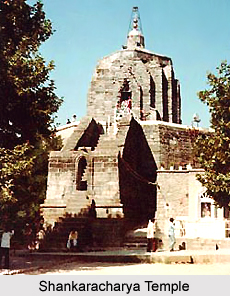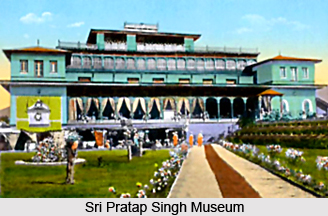 Srinagar is defined as the city of elegance and great antiquity. It is the summer capital city of Jammu and Kashmir and is located at the Kashmir Valley. It stands at a height of (5,227 ft) on the Dal Lake and Jhelum River. Srinagar is popular for its picturesque scenic beauty, simmering lakes and beautiful houseboats and also for its dry fruits and traditional handicrafts. It is a popular tourist place in itself and is also used as a stepping-stone to Ladakh. Amidst all that, Srinagar is also known for the presence of some ancient monuments that are historically significant.
Srinagar is defined as the city of elegance and great antiquity. It is the summer capital city of Jammu and Kashmir and is located at the Kashmir Valley. It stands at a height of (5,227 ft) on the Dal Lake and Jhelum River. Srinagar is popular for its picturesque scenic beauty, simmering lakes and beautiful houseboats and also for its dry fruits and traditional handicrafts. It is a popular tourist place in itself and is also used as a stepping-stone to Ladakh. Amidst all that, Srinagar is also known for the presence of some ancient monuments that are historically significant.
Historical monuments in Srinagar
Srinagar has a rich religious and political history. Being inhabited by several religions and ruled by different dynasties in the bygone eras, Srinagar boasts of some magnificent historical remnants.
Shankaracharya Temple
Shankaracharya Temple is one of the major monuments of Srinagar. It is located on the hill called `Takht-e-Suleiman` at a height of almost 1100 ft. above the surface level. This temple was constructed by Raja Gopadatya in 371 BC, and he gave it the name of `Gopadri`. It is believed that great philosopher `Shankaracharya` stayed here during his visit to Kashmir for reviving `Sanatan Dharma`. This incident eventually led to the renaming of this temple as its present one. This temple is dedicated to God Shiva and it is actually the oldest place of worship in the valley of Kashmir.
Hazratbal Shrine
Hazratbal Shrine, a Muslim shrine of this city is one of its most renowned monuments. This important Islamic shrine is situated on the banks of Dal Lake. The origin of its name comes from `Hazrat`, an Arabic word that means majestic and pure and from the Kashmiri term `bal`, which means place. It is believed to have existed since the 18th century.
Jama Masjid
Another popular monument of Srinagar is `Jama Masjid`. This mosque is situated at the centre of the old city. It is considered as an important mosque and it was founded by Sultan Sikandar in 1400 AD. This mosque reflects wonderful Indo-Saracenic architecture. It has four arched openings in the centre of each side covered with pyramidal roofs. There are three pagoda-shaped minarets and over 370 pillars support the roof, each made of deodar tree trunk.
Mosque of Akhund Mulla Shah
`Mosque of Akhund Mulla Shah` was built in the year 1649 by Shah Jahan`s son. It is really unique and unusual as it was built in stone rather than wood and externally it has rectangular panels enclosing cusped arches.
Shah Hamadan
There is another fine mosque called the `Shah Hamadan`. It reflects the typical wooden style of architecture of Kashmir. The stonework plinth is composed of old temple fragments while the body of the mosque is a simple cube covered by a pagoda-like roof. It was first built in 1395 CE, commissioned by Sultan Sikendar.
 Kheer Bhawani
Kheer Bhawani
Another popular monument of this magnificent city is `Kheer Bhawani`. This temple is devoted to goddess "Kheer Bhawani". This temple is located near the village of Tula Mula over a sacred spring. The date of construction of this monument is unknown.
Pattar Masjid
The old Pattar Masjid, built in 1623 reflects provincial Mughal style. It was actually dedicated to Empress Nur Jahan and was built under the supervision of the architect Malik Haidar Chaudara. It is now used as a granary.
Pari Mahal
In the year 1635, Dara Shukoh, eldest son of Shah Jahan, built the Pari Mahal or the Palace of Fairies. It was reputed to have been a school of astrology but is now in ruins. Five terraces of this palace can still be seen along with the remains of fountains and tanks behind the ruined facade which lie on an inaccessible spur of rock.
Hari Parbat Fort
Hari Parbat is also known as Sharika Peeth among the Hindus and locally known as Koh-e-Maran. The first part of the fort was built by the Mughal Emperor Akbar in the year 1590. During this time Akbar built the outer wall of the fort. As Emperor Akbar left his job undone, later on in 18th century the construction of this fort was completed by Atta Muhammad Khan who was an Afghan Governor.
Sher Garhi Palace
Sher Garhi Palace is located in the southern parts of river Jhelum and is an important landmark of this beautiful city. Sher Garhi stands for tiger fortress. It was in the year 1722 when Jawansher Khan the Afghan Governor constructed this place and named it as Sher Garhi Palace.
Sri Pratap Singh Museum
Sri Pratap Singh Museum houses a collection of over 80,000 objects from various regions in Northern India. It exhibits interesting collection of Kashmiri relics in different forms like objects, crafts, etc. This archeological museum, also known as SPS Museum, was established in 1898.



















